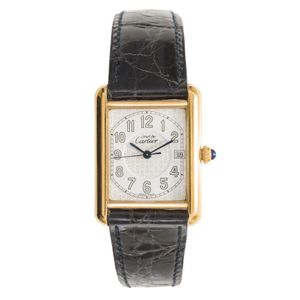Gilt Bristol Glass Cornucopia on Alabaster Plinth
You must be a subscriber, and be logged in to view price and dealer details.
Subscribe Now to view actual auction price for this item
When you subscribe, you have the option of setting the currency in which to display prices to $Au, $US, $NZ or Stg.
- Alabaster - Alabaster is soft natural stone used for statuary, with a similar appearance to marble, but easier to work with. As it is softer than marble, an item made from alabaster can be scratched with a metal object, and an alabaster item does not polish to a high surface gloss like marble.
Alabaster objects can be semi-translucent. Alabaster occurs in a pure white form and also with veining from dirt. Colours vary from white through yellow and pink to brown. The veining is usually green or black but can be multicoloured.
Being semi-translucent, alabaster is often used for the bowls of figural lamps, with the figure itself being either alabaster or marble. - Cornucopia - The cornucopia, literally the horn of plenty, is a symbol of abundance and wealth. It is traditionally is represented by a curved goat horn overflowing with grain and fruit.
Modern cornucopias are often depicted as horn-shaped baskets filled with food, and this symbol is often associated with the harvest. This decorative device has a long and ancient history, with roots in Greek mythology.
In one version, when Zeus was playing with the goat Amalthea he accidentally broke off one of her horns. To atone for this, Zeus promised Amalthea that the horn would always be full of whatever fruits she desired. This became the cornucopia of the Roman goddess Copia, the personification of plenty. Other goddesses, including Fortuna and Pax, also held the cornucopia.
In furniture and decorative arts, cornucopia as a decorative element have been popular since the 16th century and can be found on items as diverse as light fittings and candelabra to clocks, sculpture and statuary and furniture.
In ceramics, cornucopia shaped vases were popular in the 19th century, in singles and pairs.
This item has been included into following indexes:
Visually similar items

A diamond and beryl pendant on collar. The square green beryl in a circular diamond set frame. 18ct white gold. Diameter of pendant 2.3 cm. Width of collar 3.05 mm.

A ladies Cartier Tank wristwatch, quartz movement, rectangular dial with Arabic numerals, date apperture at six, signed case, dial and movement, vermeil case and original leather bands with deployment clasp, case 25 x 22 mm

Bohemian glass perfume bottle etched Desna to base, 12 cm high approx.

A mahogany serpentine sideboard of restrained form, English, early 19th century, 90 cm high, 156 cm wide, 70 deep
